 November 1935 saw Phil Kimmelman being born into a world in turmoil. Dictatorial powers ran wild through Europe and Asia. The United States, crippled by the Great Depression, was locked into an internal struggle over the issue of getting involved or isolating itself. Such things were the topics of discussion in the Washington Heights grocery store owned by Phil’s father.
November 1935 saw Phil Kimmelman being born into a world in turmoil. Dictatorial powers ran wild through Europe and Asia. The United States, crippled by the Great Depression, was locked into an internal struggle over the issue of getting involved or isolating itself. Such things were the topics of discussion in the Washington Heights grocery store owned by Phil’s father.
The Kimmelmans lived at 4530 Broadway, a building called Chaban Hall for elusive reasons. Across the street Fort Tryon Park, with its Botanical Gardens, afforded a relaxed stroll to the Hudson River. By the time Phil was ten the situations overseas were less severe and America’s economy was on the mend. Phil made friends easily. One was neighborhood girl Dorothy Tilove. They shared an artistic eye.
High school brought him into contact with other young artist, leading to the experimental animation studio in Brooklyn that Phil Kimmelman operated with Dante Barbetta and Pablo Ferro. Next thing they knew it was August of 1953. Phil and Dante were inking at Famous Studios on cartoons of BABY HUEY and POPEYE. Phil became notorious for the caricatures he drew of other personnel.
Job security depended on how many pages an inker finished each week. Piles of pages from different scenes were laid out on a table at the back of the room. Upon finishing one scene an inker would go choose another. Most people grabbed up the simplest to keep their numbers high. Phil always took the most complex scene on the table. Management questioned why his finished cel counts were so low, and Kimmelman explained that he didn’t become an artist to do the easy stuff.
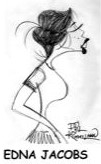 Between cartoons at Famous the artists sometimes freelanced for smaller commercial studios. Phil got called over to UPA, then a hot ticket, so they could assess his skills. Unfortunately, Phil was placed next to the voluptuous Edna Jacobs and couldn’t concentrate all day. UPA never invited him back. At Famous Studios he earned a reputation as a cut-up. Within a few months he and Dante both stepped up to the inbetweening department.
Between cartoons at Famous the artists sometimes freelanced for smaller commercial studios. Phil got called over to UPA, then a hot ticket, so they could assess his skills. Unfortunately, Phil was placed next to the voluptuous Edna Jacobs and couldn’t concentrate all day. UPA never invited him back. At Famous Studios he earned a reputation as a cut-up. Within a few months he and Dante both stepped up to the inbetweening department.
Always ready to join in on a practical joke, Phil bought a rear-view mirror at an auto parts store. He mounted it to the side of his drawing desk to watch for studio manager Sy Schultz sneaking around. Schultz smiled and made him remove it.
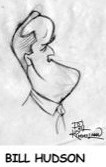 Animator Bill Hudson repeatedly advised Phil he was keeping his eye on him, always vague about whether it concerned Phil’s potential or his pranksterism. Hudson felt Kimmelman might be better suited to the smaller commercial studios becoming so plentiful around Manhattan. Bill Hudson introduced Phil to Steve Muffati, who was then directing for Chad Associates.
Animator Bill Hudson repeatedly advised Phil he was keeping his eye on him, always vague about whether it concerned Phil’s potential or his pranksterism. Hudson felt Kimmelman might be better suited to the smaller commercial studios becoming so plentiful around Manhattan. Bill Hudson introduced Phil to Steve Muffati, who was then directing for Chad Associates.
Chad Grothkopf, already a noted comic book artist, entered animation almost as a lark, and sent the New York scene into a spiral. Grothkopf worked from his apartment with Steve Muffati supervising animation. Kimmelman signed on as Muffati’s assistant to get detailed schooling in theatrical style animation.
Around April 1954 Chad hired some top-notch talent and moved onto the 14th floor of 40 East 49th Street. On a whim, Phil started throwing rubber erasers at the other animators. They chased Phil down the hall and he locked himself in the boss’s office. Agitated animators waited outside, threatening to de-pants Phil and drag him in among the ladies of ink-and-paint. Phil climbed out the window – the 14th floor window – wondering if he’d gone too far this time. He climbed in another window, emerged down the hall, crept up behind the mob, and started throwing erasers at them. Off came Phil’s pants!
 Chad Grothkopf’s business practices were unorthodox. One day Steve Muffati didn’t show up. A few days passed, and still no word from Muffati. Chad Grothkopf asked Kimmelman if he knew where Muffati was. Kimmelman did know. He was the only one who knew, but had been sworn to secrecy. Union officials were asking after Muffati too. It seems Chad’s hiring practices destabilized the whole New York animation industry. Phil Kimmelman’s friend Pablo Ferro warned Phil that Muffati would drag him down. Under considerable pressure from all sides, Phil kept his oath to Muffati.
Chad Grothkopf’s business practices were unorthodox. One day Steve Muffati didn’t show up. A few days passed, and still no word from Muffati. Chad Grothkopf asked Kimmelman if he knew where Muffati was. Kimmelman did know. He was the only one who knew, but had been sworn to secrecy. Union officials were asking after Muffati too. It seems Chad’s hiring practices destabilized the whole New York animation industry. Phil Kimmelman’s friend Pablo Ferro warned Phil that Muffati would drag him down. Under considerable pressure from all sides, Phil kept his oath to Muffati.
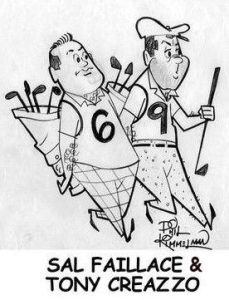 Chad Grothkopf offered Phil Kimmelman a promotion to full animator. The whole situation made him uncomfortable. Phil felt he wasn’t ready yet, and honestly thought either Sal Faillace or Tony Creazzo were far better suited. Grothkopf might have fired Phil over his refusal, except Muffati returned. Early in 1956 Chad Associates collapsed under its own weight. Muffati went to Transfilm. Kimmelman followed Sal Faillace to Lars Calonius Productions.
Chad Grothkopf offered Phil Kimmelman a promotion to full animator. The whole situation made him uncomfortable. Phil felt he wasn’t ready yet, and honestly thought either Sal Faillace or Tony Creazzo were far better suited. Grothkopf might have fired Phil over his refusal, except Muffati returned. Early in 1956 Chad Associates collapsed under its own weight. Muffati went to Transfilm. Kimmelman followed Sal Faillace to Lars Calonius Productions.
Lars Calonius made a name for himself at Disney before moving east to co-found Archer Productions, where they produced the classroom safety film DUCK AND COVER. Calonius eventually formed his own company at 45 West 45th Street, hiring away some of Chad’s top personnel: Ron Fritz as a designer, and Dan Hunn as an animator. Muffati was right next door at Transfilm. Dante worked next door to that at Famous, and Pablo was a block north at Elektra Films.
After a few months Muffati invited Phil to be his assistant at Transfilm. Whenever the crew went to lunch at the local steak house Phil smothered his steak with catsup, and they would poke fun at him. One of Transfilm’s cameramen gave Phil a tour of that department, having rigged an old lever onto one of the cameras so it fell off as soon as Phil touched it. The cameraman terrified Phil into believing he’d broken a brand new, very expensive piece of equipment. Muffati kept a little bell on his desk that he’d jangle when something amused him. One day Kimmelman lit a stink bomb on a supply shelf and nearly started a fire. No one was amused.
His co-workers held a party in the conference room on Phil’s twenty-first birthday, gifting him twenty-one neatly wrapped packages. Each contained a bottle of catsup. Chad Grothkopf returned in 1957 with a new studio called Chadwick in his apartment at 80 Park Avenue. Steve Muffati directed films at Chadwick with Phil Kimmelman as his assistant animator. That summer Phil joined Pablo for a vacation in Miami and Cuba. They visited Havana while Fidel Castro was battling to take over the city. Phil and Pablo were hanging out the abandoned office of President Batista when they heard gunfire down the street.
Phil arrived home safely to rejoin Lars Calonius Productions. Duane Crowther had been a top guy at UPA and was now production supervisor for Calonius. Duane Crowther taught Phil Kimmelman to eliminate excess drawings, streamlining the old theatrical animation style for the smaller screens of television. The business was no longer so much about Mickey Mouse and the Oscars as it was about pleasing some ad agency’s client with a sixty second spot.
Those ad agencies grew ever more influential in the animation business. Lew Gifford, an artist/copy writer at one of the biggest firms, opened Gifford Animation on Lexington Avenue.
Pablo Ferro signed on as animation supervisor. Pablo’s assistant from Elektra, Fred Mogubgub, came over with him. Ed Smith, current editor of the union’s Top Cel newsletter, worked at Gifford Animation. Kimmelman joined them to share an office with Mogub.
Ed Smith also drew satirical caricatures. When Phil Kimmelman called in sick because of measles he was ashamed to admit to having a children’s disease. Secretary Julia Whalen swore she’d keep it between them. Kimmelman returned to work the next week to find little red dots painted all over the light bulb at his desk. Ed Smith then joked about it in Top Cel. Phil’s discomforts became a running gag. When Phil burned himself with hot soup from a Chinese restaurant, Top Cel reported he was recuperating from “Wontonitis”.
Gifford Animation made a theatrical cartoon called CRASH TEST BUDDIES starring the comedy team of Bob and Ray. Al Eugster and Vince Cafarelli animated on it. Midway through production Kimmelman was drafted into the Army. Aside from a slow buildup of military advisors in Vietnam as a bulwark against Communism’s “domino effect”, the U.S. wasn’t in any shooting wars at that time. Pablo informed him that some other animators used a certain doctor to be excused from duty, but Phil wouldn’t have
it. Time to grow up.
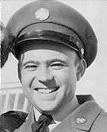 Phil Kimmelman married his childhood friend Dorothy Tilove right after boot camp. He was stationed at the West Point Military Academy on the Hudson River, about an hour’s drive north of New York City. Kimmelman drew for the Army newspaper, composed charts and training aids for the cadets, and worked on huge maps. At first he lived in the barracks, but was soon allowed to take an apartment near the base with Dorothy.
Phil Kimmelman married his childhood friend Dorothy Tilove right after boot camp. He was stationed at the West Point Military Academy on the Hudson River, about an hour’s drive north of New York City. Kimmelman drew for the Army newspaper, composed charts and training aids for the cadets, and worked on huge maps. At first he lived in the barracks, but was soon allowed to take an apartment near the base with Dorothy.
Pablo Ferro was back at Elektra Films, this time as a director. He threw Phil some side work.
Dorothy would travel into the city and pick up assignments from Elektra. Phil’s younger brother Ken Kimmelman followed in his footsteps, becoming a member of Screen Cartoonists Local 841. Steve Muffati was working for Joe Oriolo on FELIX THE CAT. Phil and Dotty had a son.
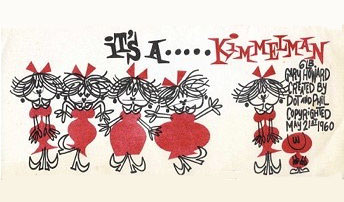
They bought a house in Queens before Phil was discharged at the rank of Corporal in late 1960. On his last day Phil got lost between West Point and his new house, so Dotty had to go rescue him. Phil took an animator’s position with the Hankinson Studio at 15 West 46th Street, a few doors from Elektra. Phil drew a long-running PSA about pedestrian safety with the jingle DON’T CROSS IN THE MIDDLE by composer Vic Mizzy (best known for the ADDAM’S FAMILY and GREEN ACRES theme songs). Fred Hankinson only paid his head animators an assistant’s wage, so Pablo got Phil in at Elektra Films.
Pablo Ferro soon left to start his own company. Elektra offered Phil Pablo’s slot as director. He nearly turned it down due to anxiety, but Jack Goodford, the other director, assured him it would be fine. Goodford, formerly a big shot at UPA, guided Phil through the intricacies of Elektra’s process. Phil would take the train into Manhattan on Saturdays to meet at Jack Goodford’s apartment. Phil often had to wait in the lobby while the woman from Goodford’s latest one-night-stand collected herself, passing Phil on her way out.
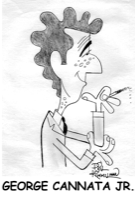 Respectability. Phil was selected as a member of the union’s executive board. He worked with top talent. Designers were as important as animators on those commercial jobs, and Phil got the best of them: George Cannata Jr.; Dolores Cannata; R. O. Blechman; Edna Jacobs; Bill Peckmann; Cliff Roberts – if they conceived it, Phil Kimmelman figured out how to make it move, using phenomenal animators such as Jack Dazzo, Willis Pyle, Howard Beckerman, and many others. Phil became close friends with Jordan Caldwell, head of Elektra’s ink-and-paint department.
Respectability. Phil was selected as a member of the union’s executive board. He worked with top talent. Designers were as important as animators on those commercial jobs, and Phil got the best of them: George Cannata Jr.; Dolores Cannata; R. O. Blechman; Edna Jacobs; Bill Peckmann; Cliff Roberts – if they conceived it, Phil Kimmelman figured out how to make it move, using phenomenal animators such as Jack Dazzo, Willis Pyle, Howard Beckerman, and many others. Phil became close friends with Jordan Caldwell, head of Elektra’s ink-and-paint department.
Jack Goodford taught a night class at the School of Visual Arts, and sometimes Kimmelman filled in for him. Bill Peckmann, studying to be a designer, impressed Phil, who hired Peckmann as his assistant at Elektra in 1962. Kimmelman schooled Peckmann in the art of inbetweening. About that time, Goodford moved on to Robert Lawrence Prosuctions, leaving Phil as top dog at Elektra’s animation department.
Kimmelman socialized in the bars and diners of Times Square, witnessing many offbeat encounters. Advertisement agency people mingled with cartoonists, trying to determine what happy medium might please their mutual clients. Liquor flowed.
Elektra’s creative director Lee Savage once beat the tar out of actor Montgomery Cliff’s brother in the Rustic Bar. The antics of Pablo Ferro and Fred Mogugub kept Phil on his toes.
In 1965 designer Chris Ishii made a move. Trade periodicals of the time ran the press release:
Chris Ishii! Designer at Disney. Prisoner of war in Japanese internment camp. Top Sergeant in Army Signal Corps. Back at Disney, like nothing even happened, but eyeing that East Coast action. Creative head of UPA’s New York office beside Jack Goodford. Top designer at Tempo Productions. Shamus Culhane Productions. Vice Presidency at Pelican Films. Now among the high-octane players creating Focus Presentations, Incorporated.Five veteran advertising executives and film makers in New York have formed Focus Presentations, Inc., which will specialize in live action and animated film commercials and programming for television. Offices are at 400 Park Avenue. President of the new company is Eli Feldman, who for the past seven years was a vice-president at Pelican Films. He had previously spent four years at Dancer- Fitzgerald-Sample in commercial production, and for the two years prior to his joining Pelican he was in charge of sales at UPA. Chris Ishii, vice-president and director, was formerly co- creative head of UPAs New York office.
Focus Presentations was composed of divisions to do separate tasks. In 1966 they added an animation division called Focus Designs. Chris Ishii was executive vice president. Cliff Roberts, who Ishii knew well from UPA, was a vice president and creative director. Phil Kimmelman, who Cliff Roberts knew well from Elektra, was invited to supervise animation. What’s not to like?
Bill Peckmann went over with Phil. Focus Designs had room for half a dozen people. Talks took place with Total Television Productions on Madison Avenue to do a NOAH’S LARK television series. Phil was set to direct them all, but the project died in preproduction.
TV commercials paid the bills. Designer Rowland Wilson contributed to teleblurbs for Vote Tooth Paste and Flying “A” Gasoline. Focus Designs enlarged, being the only subsidiary of Focus Presentations to earn a steady profit. Cliff Roberts’ alcoholism got him fired. Phil Kimmelman regretfully replaced
Roberts as v.p. and creative director. Cliff Roberts bounced back by starting Poverty Pictures in 1967. He invited Phil Kimmelman in, but it didn’t seem like the right move. Focus hired Gordon Whittier and Victor Barbetta as animators. Dante Barbetta joined his brother at Focus in mid 1969. Michael Sporn was there inbetweening. Harvey Kurtzman from MAD Magazine designed some segments for Children’s Television Workshop. Focus was part of the cultural-landscape with their animated television ads for clients such as Dow Scrubbing Bubbles, M&Ms candy, Cheetos cheese snack, Michelin tires, and Honeycombs cereal.
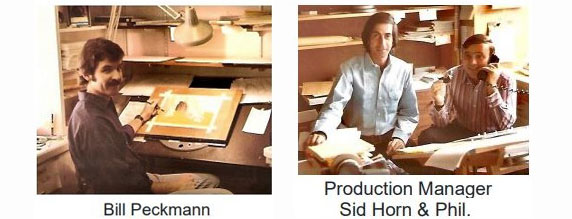
Phil spent much of his day coordinating with ad agencies. In 1971 McCaffrey & McCall Advertising brought Focus Designs to do a couple educational shorts. The concept was SCHOOLHOUSE ROCK. Animated songs would inform kids. The first two were done at Focus. But Phil wasn’t happy there. His division’s income kept the parent company afloat, and yet they refused to honor some fine points in his contract. When McCaffrey & McCall tried to hire Phil away, he said that what he really wanted to do was open his own studio. McCaffrey & McCall fronted him sixty thousand dollars to do just that.
SCHOOLHOUSE ROCK went into full production during 1972 with Phil Kimmelman & Associates, located at 65 East 55th Street, next door to the Friars Club. MAD Magazine’s Jack Davis designed the logo for PK&A.
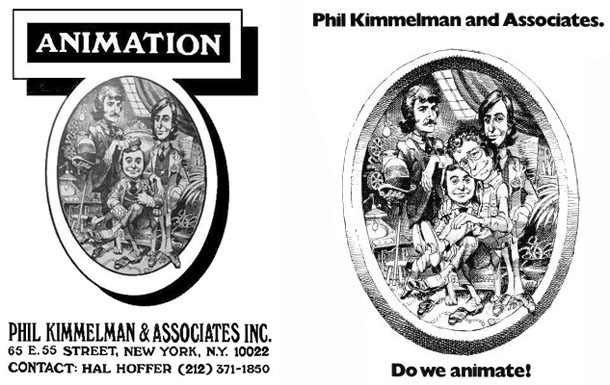
Harvey Kurtzman freelanced at PK&A. Phil was pretty tight with some of the MAD guys. Sergio Aragonés, who Phil greatly admired, played tennis with him. Phil tried to let Aragonés win, but couldn’t play badly enough Bill Peckmann, Phil’s right-hand man, was on deck. Mordi Gerstein hid out at PK&A a while. Agnes Cannata, Dotty’s friend from high school, did designing. Dotty kept an eye on finances. The old Industrial Arts crew making good. Schoolhouse Rock segments bounced aling. M&Ms wanted TV spots while other commercial work rolled in: Fritolay … Dow Chemical . . . Exxon . . .
General MILLS paid PK&A big money for a Cheerios spot. Phil brought Pablo Ferro in to really give it some Zing, some Zap, you know, magic, the old razz-ma-tazz! Phil’s artistic side needed some exercise, or he might morph into an ad executive.
Bill Peckmann had production under control. Time for a special project with an old friend. Twenty years ago Phil Kimmelman, Pablo Ferro, and Dante Barbetta had started a studio in Brooklyn. Now Phil was the boss of a serious firm. Pablo headed another. Dante was occupied at the New York Institute of Technology with a team developing computer programs to do animation.
Yeah! Like that could ever work!
It was time to indulge. Phil and Pablo settled into some late night sessions, deconstructing what the ad agency provided – what the client asked for – The two creative forces reassembled that teleblurb into their own image. It was like being young again, back at Gifford Animation. Phil was
engaged to Dotty back then. Pablo didn’t approve. Not that Dotty wasn’t a fine girl. They all hung out in high school. Pablo just thought Phil shouldn’t tie himself down so soon. It led to a rum-fueled fist fight one night when Phil and Pablo were alone at Gifford. The quickest way to get past that was more rum in the African Room at Broadway and 44th Street.
With that Cheerios ad they meant to revolutionize animated commercials. Phil and Pablo poured their hearts and souls into the thing. How surprised their client would be. Well, when they ran it up the flagpole, nobody saluted. General Mills was furious.
PK&A survived the Cheerios fiasco. Mort Drucker, Herb Trimpe, and William Steig designed commercials.
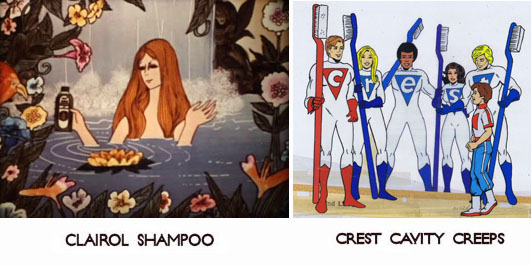
PK&A churned out high quality ads: Cheetos, Honey Combs, Purina Cat Chow, Underoos, Tang, Irving Trust, Burger King, Calgon, Michelin, Country Time, Avis, Granny Goose, Piel’s Beer, Vick’s nasal spray . . . Sal Faillace was top animator at PK&A. Vinnie Bell took up slack, mostly working from home. Phil chose different freelance animators, matching their styles to each job. Tissa David and Lu Guarnier were regulars. Jack Schnerk, Bill Tytla finished up his career there. Sal Faillace became ill and Vinnie Bell stepped up.
Kimmelman and Peckmann concentrated on SCHOOLHOUSE ROCK. They were plugged directly into Spiritus Mundi. The ABC Network promoted the idea of educational animated content, and SCHOOLHOUSE ROCK was their shining star. Not only did it teach math, science, grammar, and such – each film was a lesson in music and graphics as well. Kimmelmann were involved in each film. The NYC area’s great musicians recorded songs in a wide range of styles. Phil and Bill picked the right designer and animators for every job. The Bluesy I’M JUST A BILL has been shown to classes preparing foreigners to apply for U.S. Citizenship.
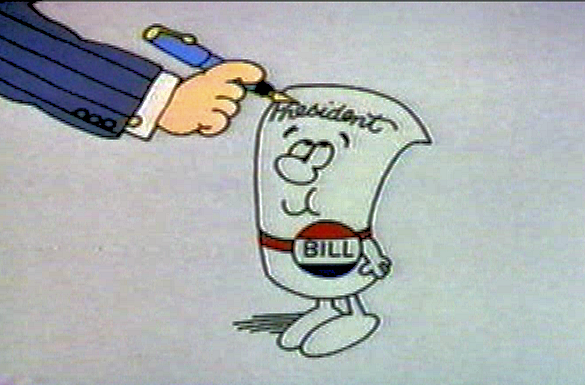
Phil reconnected with Jordan Caldwell around 1980. Elektra was gone and Caldwell produced live-action commercials. Phil and Jordy threw in their lot together. Film director John Michaeljohn and Caldwell’s assistant Jim Parker were in the mix, founding Kimmrlman-Caldwell-Michaeljohn-Parker at 49 th Street and Madison Ave. KCMP made commercials.
Their client Coca Cola had a tie-in going with Disney in the mid-80s. Mickey Mouse, Donald Duck, Goofy, and Pluto schilled Fanta soda. KCMP shot live-action commercials, super-imposing animated Disney characters. In keeping with his policy of using the right artist for the right job, Phil hired Disney artists like Glen Keane. This had to be done without Disney’s knowledge, or those artists would have been fired.
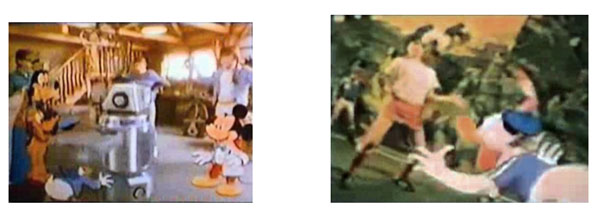
Phil and Dotty moved to the Berkshires. M&Ms remained a steadfast client. Bill Peckmann was still there. About 1989 KCMP developed some budgetary problems. Dotty got on the phone to collect delinquent payments. The whole situation caused Phil to separate his studio, and so Phil Kimmelman Animation was born to meet KCMP’s needs while Phil also pursued his own clients.
M&Ms decided to switch over to computer generated animation, which Phil’s studio did not handle. He was being considered to redesign the M&M characters when he found out Jordan Caldwell was representing a British studio competing for the same job. Phil stopped dealing with Caldwell.
Phil’s younger brother Ken Kimmelman had a successful animation career, winning awards including an Emmy. Sadly, a deep philosophical divide drove the two men apart. Harvey Kimmelman, the youngest brother, ran a graphics studio at 50 West 40th Street near Bryant Park. Harvey would be glad to have
Phil use some space as Kimmelman Studios, Inc.
In 1991 the Walt Disney Company asked Phil Kimmelman to co-direct the art department of their Consumers Affairs department.
He was working for Disney! What might have been fulfillment of a lifelong dream turned into the unhappiest year of his career, beset by bickering, back-stabbing, and locked doors.
Phil was independent again in 1992. He auditioned for a director’s position at Cologne Cartoons in Germany. Cologne wanted an English speaking director for their series NATURE KNOWS BEST.
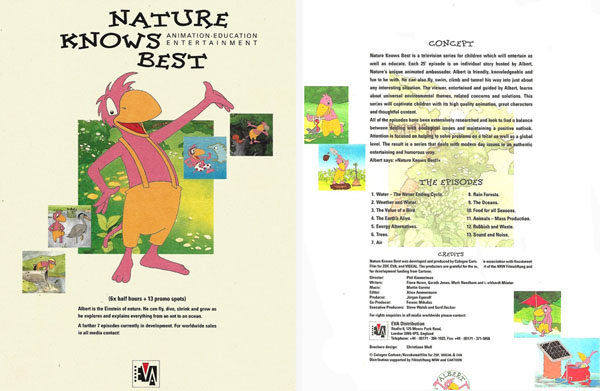
Phil’s abysmal grasp of the German language resulted in an agreement that the Cologne crew would address him in English at all times. Kimmelman alternated every other month between Cologne and the Bershires. He stepped away from SCHOOLHOUSE ROCK, and J.J. Sedelaier Productions turned out a couple in White Plains. Bill Peckmann took to freelancing.
After two years back-and-forth, Phil resigned from Cologne Cartoons. He wanted to get back to basics as an artist, personally creating two of the SCHOOLHOUSE ROCK money episodes. He rolled up his sleeves, doing design, layouts, and animation on both.
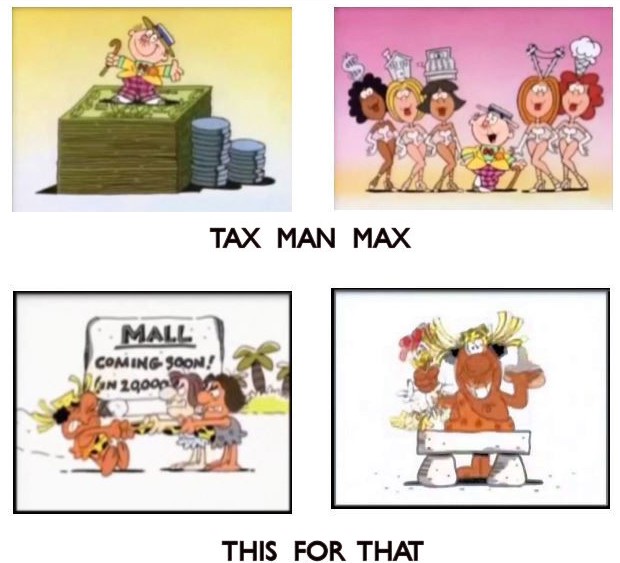
Phil retired in 1997. He was sixty-two years old. The Kimmelmans relocated to Florida. He kept his hand in from a home studio, being ready in 2003 when the SCHOOLHOUSE ROCK people reunited for the one-shot I’M GONNA SEND YOUR VOTE TO COLLEGE. They followed that with the environmentally conscious EARTH ROCK.
As of this writing Phil is preparing a book featuring his caricatures of animation industry personnel.
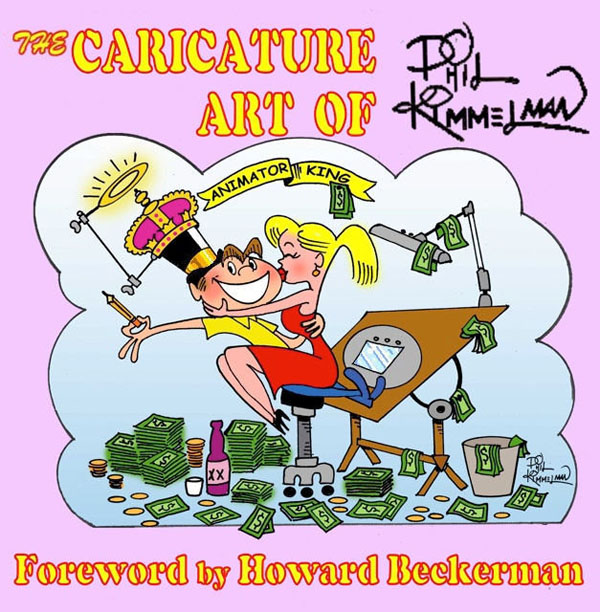


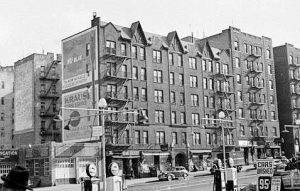
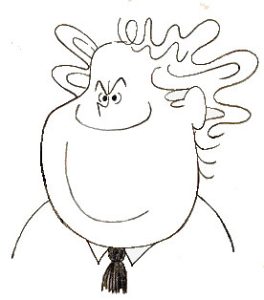
 BOB COAR made his way in this world as a muralist and sign painter, illustrating on just about every surface imaginable. A life-long fan of animation, he is currently searching for digital, or actual, copies of Top Cel.
BOB COAR made his way in this world as a muralist and sign painter, illustrating on just about every surface imaginable. A life-long fan of animation, he is currently searching for digital, or actual, copies of Top Cel. 



































Breezy, picaresque, entertaining article about the many lives of a New York animator… but, hey, what about this Bob & Ray “Crash Test Dummies” short cartoon? Tell us more about that.
We’ll come back around to that eventually. In time I hope to cover all the main teleblurb studios.
The “I’m Just a Bill” installment of SCHOOLHOUSE ROCK was sung by Jack Sheldon, who also sang the parody “I’m an Amendment to Be” on THE SIMPSONS many years later. Sheldon was a very busy studio session trumpeter for many years. When Grandpa cast a spell on Eddie Munster turning him into a jazz musician, it was Jack Sheldon who recorded Eddie’s red-hot trumpet solo.
I remember a lot of Kimmelman’s commercials. The one for Clairol Herbal Essence Shampoo is arguably the most beautiful animated TV commercial ever made.
There are a few Richard Williams spots competing.
“Schoolhouse Rock” recently marked its 50th anniversary. Everyone remembers the cartoons, the jokes, the catchy songs, everything except what they were supposed to learn from them.
Wrong, sir. It really helped me remember the multiplication table and believed me, that was important.
And what about Paul Kim and Lew Gifford?
I actually believe that for a while, the Fanta/Disney commercials were done by Richard Williams. (I mean, it DOES have live action people interacting with Disney characters…) Turns out I was wrong. You can thank Bill Peckmann for making me change my mind.